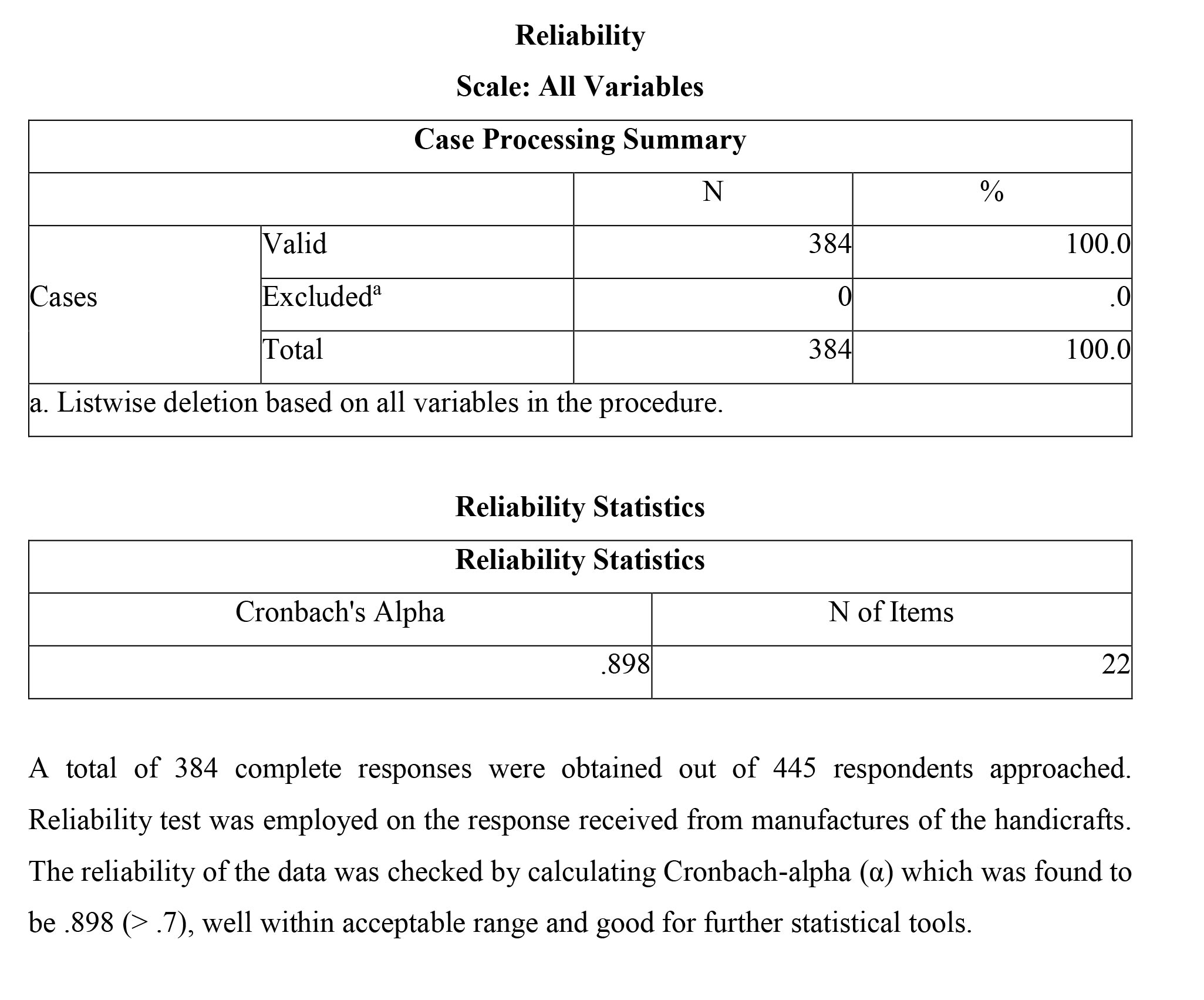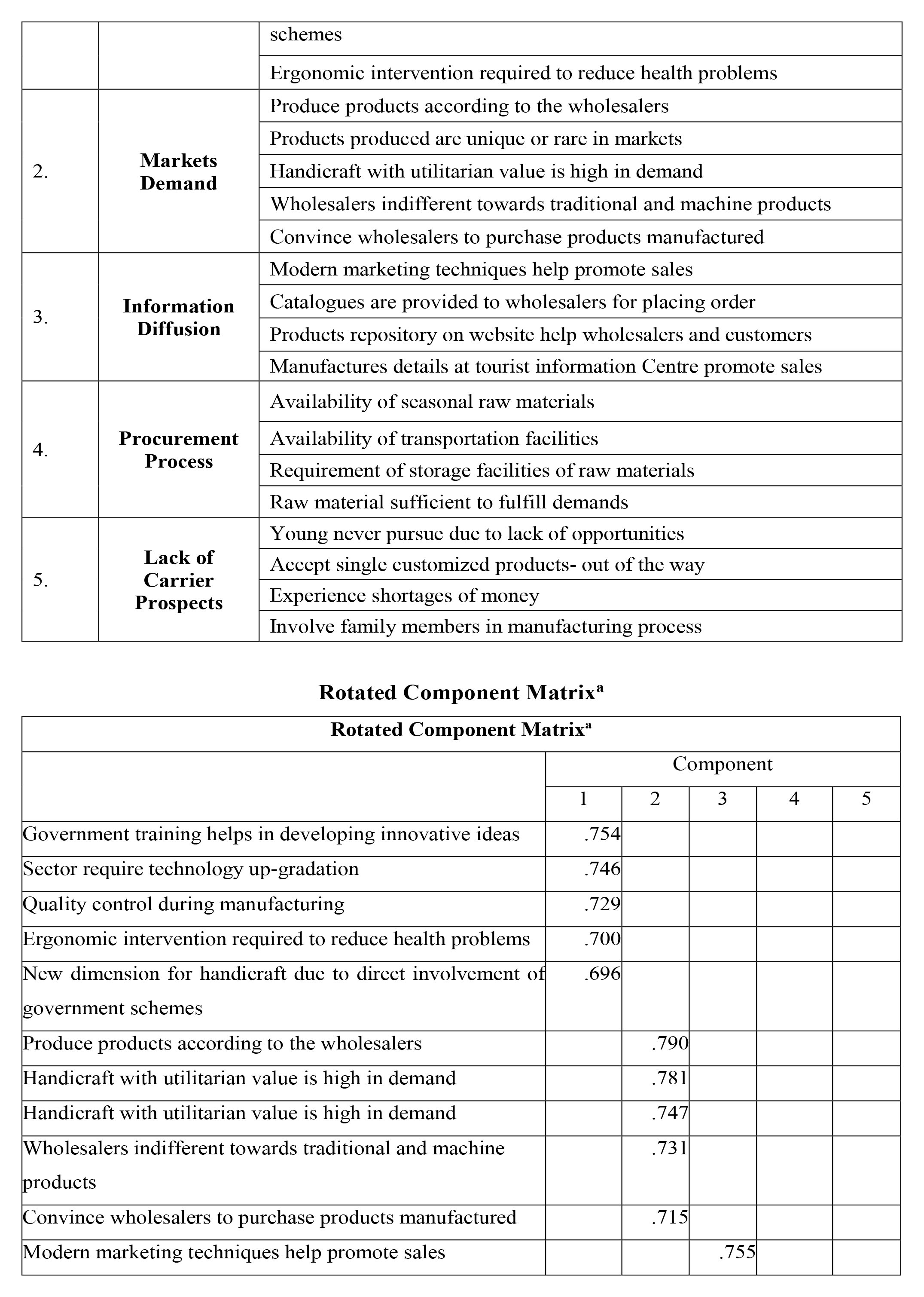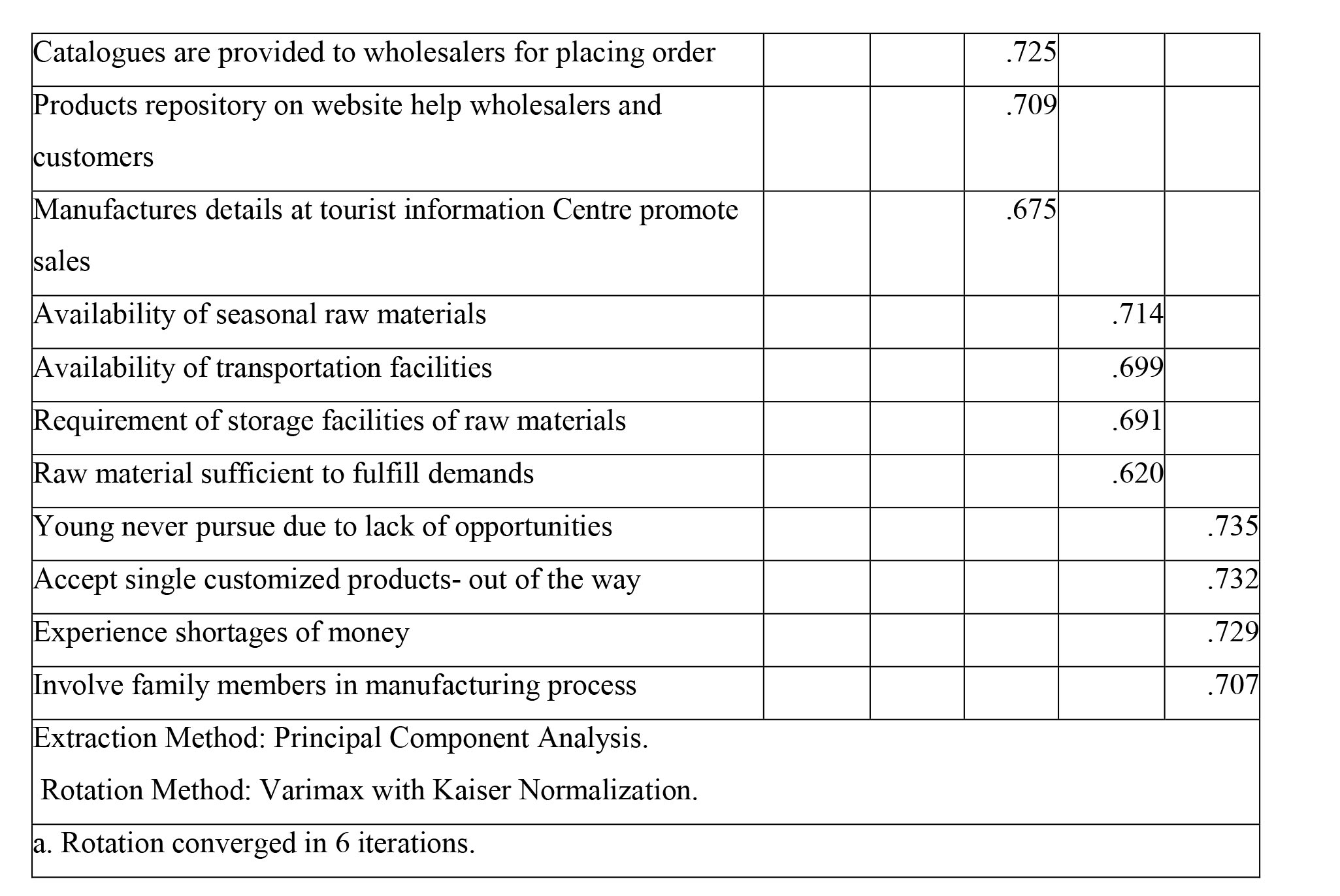Subscribe now to get notified about IU Jharkhand journal updates!
An Analysis of Influencing Factors in Production of Handicraft Sector in India
Abstract :
Handicraft has been most diversified sector in India which scattered each state of the country. It is second largest employment generating sector after agriculture and mostly cottage-based production. The artisans of the crafts have plays fundamental responsibility to produce the quality products to the market but production section of the craft has facing so many problems, which adversely effects the overall sector. In this study, we investigate the most prominent issues related to the production section of the crafts which influence the handicraft sector.
The major influencing factors of the production section are fundamental support, manufacturing prospects, Information dissemination, procurement process and obstacles& Obstruction. These factors help to build up a elementary framework for the production of the crafts products and also provide a competitive products in the markets.
The paper is divided into four sections in which, the first sections discuss about the production section of the handicraft. The next section includes review of literature of different parameters of the production which influence the making of the handicraft sector. The third section deals about the objectives and research method of the paper and fourth part of the paper includes data analysis and interpretation of the influencing factors of the handicraft sector. The last section includes the findings and conclusions of the paper which highlighted the most influencing construct which control the whole production part of the handicraft sector.
Keywords :
Handicraft, Production, Quality, Traditional, Markets, Customers etc.Introduction
As we know that Indian handicraft sector is an oldest sector, which spread throughout the country with different customs and traditions. It has been a legacy as a crown of a king in the world markets for their quality and diversifies of craft products. Indian handicraft was the world largest diversify products categories which attracted the customers throughout the world and also fulfill their demands according to their choices. India was the world largest handicraft products exporter and foreign exchange earner in the world market. The producers of handicrafts scattered in different parts of the country generally in the rural area.
Handicraft have a great prospective to provide jobs to existing set of millions of artisans but also for progressively a greater number of the new entrants in the sector. The most common problems which influence the overall development are lack of education, absence of market intelligence, low capital, poor exposure to new technologies and poor institutional framework (Annual Report, Ministry of Textile, 2018). The ministry of textile started so many developmental programs like social interventions, technological interventions, marketing interventions and financial intervention to promote handicraft by developing artisans’ clusters into professionally managed and self-reliant community enterprise (Annual Report, Ministry of Textile, 2017).
Zhu Yihao and Zhu Yuning (2010) in their studied they found that the, pessimistic factors like large design flexibility, pathetic and complex production process, lack of involvement of contemporary manufacturing system, which adversely influence the production of craft items. M. L Meena (2011) found that ergonomic factors have harmfully exaggerated the working condition of artisans in handicraft sector. Ergonomic factors talked about scientific studied of association between artisans and their functioning environment. The researcher tried to focus on the different factors, which pessimistically affects the efficiency of the workers. Sanjay Mahapatra (2011) said that, there is an obligation to improve the producing condition of artisans in their houses. In organized producing centre, craftsmen earned better wages, quality of products is good but in unorganized places artisans were incapable to maintain the quality of products.
The handicraft is small scale and cottage-based works which help to solve the social and economical problems of the artisans and nearly 70 lakhs of workers are involved in the production of the craft. Most of the workers belong to the weaker section of society including women artisans. The production phase of the crafts has been playing a significant to overall growth and development of the handicraft sector. There is need to examine the each and every sub segment of the craft production, so that we can find out the point of value creation in the products. As we know that most of crafts products are exported in the world market, so that we should produce the crafts according to the international standard. Domestic market of India is also a potential market and craftsmen should also provide the products according to the test and preference of the customers.
More than 7 million of the crafts persons are working as a backbone of the craft sector and government should provide training to these people, so that they use new tools and techniques in the production activities of the handicraft products. The production an activity has been plays an important role to provide a well-furnished and quality product to the customers.
Review of Literature
The prime purpose of the literature review to provide a fundamental knowledge of the said topic and to find the research gaps which provide the basic framework for the researchers for further work. According to the Neha Nagori (2012), rural artisans play a very important role in the production of handicraft products but workers are using the traditional methods which adversely affect the overall productivity. They have no knowledge about the about the contemporary marketing techniques like, quality delivery, packaging and services after sales etc. Kumar and Rajeev (2013) discussed about the internet task regarding manufacturing process, production techniques, increase visibility of crafts items and facilitate the customer through different information of the crafts products. Blerin Kola (2012), conducted his studied in Uyghur’s, with Turkin people and found that the web marketing playing a significant role in selling of crafts items to the customers. He also said that increasing competition in crafts sector pressurized the artisans to produces quality and identical products for the market.
According to the Mukherjee, et al. (2016) modern technology has been increases the focus of the handicraft sector which help to renovate the total working style of the sector. The prime focus areas of crafts were product design, quality assurance, manufacturing methods and artisans training. In the same way David Makofsky (2013), examine the role of culture and experience of artisans in the crafts items but the market scenario has been changing continuously which adversely influence the market demands. He concluded that the artisans should change the production techniques, so that they create and fulfill the demand of the markets. Ajay k. Garg, (2005) author highlighted the consequence of quality management to all organization including handicraft sector and he suggested the five dimensions like products or services quality, quality of total system of operation, attitude & its quality process, workers and management consciousness towards quality which help to maintain and improve the quality of products.
The manufacturing of crafts has been a key player in handicraft sector; likewise, Shaw (2011) described the whole procedure of manufacturing of “Bankura Horse” which comes under Terracotta crafts. It is one of oldest craft work in West Bengal which has concerned by specific caste or community people called “Kumbhkar” and they well known about all activities of works from homework of raw materials, mixing of clay appropriately, wheel work, drying, Handwork, Motifs work, final design, coloring, firing and testing and sorting. Artisan who worked in this field has faced different problems old technique and design, like lack of space, lack of quality and lack of raw materials etc. Abdusalam (2009) carried his work on design of web-based marketing appliance for handicrafts operator in Kedah, in which information technology (IT) is a pioneering idea to use in handicraft because its role is increase day by day in manufacturing, banking, finance, Academic works etc. which help to make these sectors much more competitive and innovative. It also helps to take innovative changes in the handicraft field.
Similarly, Goyal et al (2005) put emphasis on the role of quality management in handicrafts and the numbers of quality conscious customer’s increased, which increased the importance of quality products in the present days. The data were collected from different manufacturing units of craft products. They divided into based on five dimensions like quality of product or service, quality of total system of operation, quality process, attitude & consciousness of management regarding quality and workers attitude towards quality, which help to maintain or improve quality of products.
Statement of the Problem
Manufacturing segment of craft products is a backbone of handicraft sector which has been playing a significant function in the overall growth and development of the sector. But the Indian handicraft sector still uses the same traditional methods for the production of crafts items which adversely influence the effectiveness and efficiency of the craft products. In the response of this problem, our study proposes to investigate the existing factors which influence the manufacturing phase of the handicraft sector.
Objective of the study
To examine the factors, influence the production of handicraft products?
Research Methods
The research paper is descriptive as well as exploratory in character and the populations of the study were all the producers of handicraft products in Uttar Pradesh. The total sample size was 384 handicraft produces in selected districts of the Uttar Pradesh and districts were chosen through convenient sampling techniques. The primary data were collected through snow ball sampling technique from the producers of the handicraft in selected districts and secondary data were collected through research papers, mono graphs, annual reports, articles etc. used for the preparation of the questionnaire. The Cronbach’s-alpha was used to check the reliability of the questionnaire, exploratory factors analysis method used to identify the factors which influence the production of the craft products.
Analysis and Interpretation
The descriptive statistics depicted that, 91.80% respondents were male and 8.20% respondents were female. The average age of the artisans who involved in the production of the handicraft were 40-50 years, which constituted 42.60%, followed by the age group of 55-60 years with 31.50% respondents and 23.40% producer’s age group were 30-40 years. 53.60% respondents’ family size were 5-8 members, 36% artisans’ family size were 9-12 members and 18.70% producers’ family size were 13-16 members in the family. More 50% artisans were monthly earning income less the Rs.5000 per month and 24% producers were earn Rs. 10000 per month in the selected crafts in the handicraft sector.
Reliability Test




Interpretation:
According to the above table indicating the rotated component matrix, the first factor comprises of five items: Government training helps in developing innovative ideas, Sector require technology up-gradation, Quality control during manufacturing, Ergonomic intervention required to reduce health problems and new dimension for handicraft due to direct involvement of government schemes with a loading 32.456 % was named as Infrastructural Support.
The second factor consist of five items which includes: produce products according to the wholesalers, products produced are unique or rare in markets, handicraft with utilitarian value are high in demand, wholesalers indifferent towards traditional and machine products and convince wholesalers to purchase products manufactured with a loading 12.589% and factor was named as Markets Demand.
The third factor consist of four items which involves: modern marketing techniques help promote sales, catalogues are provided to wholesalers for placing order, products repository on website help wholesalers and customers and manufactures details at tourist information centre promote sales with loading of 6.883% and factor was named as information diffusions.
The fourth factor comprises of four items, which involves: availability of seasonal raw materials, availability of transportation facilities, requirement of storage facilities of raw materials and raw material sufficient to fulfill demands explaining 5.483% of variance and factor was named as Procurement process.
The fifth factor comprises of four items: young never pursue due to lack of opportunities, accept single customized products- out of the way, experience shortages of money and involve family members in manufacturing process explaining 4.618% of variance and factor was named as lack of Carrier Prospects.
Conclusions
It could be concluded that the production phase or part of the handicraft playing a crucial role in the overall growth and progress of the handicraft sector. In this section, artisans or craftsmen have direct involvement from products design up to finished products. Indian handicraft sector should focus on training should be based market demand, update technology, quality control system should be executed during productions and training should be based according to the crafts. The artisans should organize weekly meeting, in this meeting they share their knowledge, problems, government schemes, exhibitions and market information about products.
This sector should also focus on modern marketing medium like Television, magazine, newspapers, Internet, and social media such as Facebook, Instagram, We-Chat, Twitter etc. which help to increase awareness and motivate them to buy the products. The producers should keep catalogues, website for retailers, customers for better decision making and information dissemination about the available products and upcoming items. Quality, transportation, storage, availability have an important role to continue the production of crafts products. As we know that the young generation never pursues this work due to lack of career opportunities
References
Meena, M. L., Dangayach, G. S., & Bharadwaj, A. (2011). Impact of ergonomic factors in Handicraft Industries. In Proceeding of the International Conference of Mechanical production and Automobile Engineering.
Yihao, Z. and Yuning, Z. (2010). The Strategic Research of Traditional Handicraft Products' Modern Development bases on Consumer Psychology. 978-1-4244-7974-0/10.
Malhotra, N. K. & Dash, S. (2011). Marketing Research An Applied Orientation (Sixth., p. 948). New Delhi: Pearson Education, Inc.
Nagori, N. and Saxena, K. (2012). Marketing of Rural Handicraft Products through Retail Format: A Synthetic Review. Annals of Management Research, 2(1).
Makofsky, D. (2013). The Artist and the Artisan in Xinjiang (China) Central Asia: The Changing Uyghur Muslim Culture. European Journal of Applied Social Sciences Research (EJASSR), 1(1).
Garg. A. K. et. al. (2005). A Study of Quality Management in Indian Handicraft Units. Global Business Review, 2005 6:189.
Kumar, D. and Rajeev, P.V. (2013). A new strategic approach for marketing of handicraft products. International Journal of Applied Services Marketing Perspectives, 2 (3), 540-543.
Kola, B. (2012). The Marketing of the Craft Products in Albania, The Effect of Web Marketing. European Scientific Journal, 8(3).
Mukherjee, M. S., Mukherjee., M. M., & Bhattacharya, M. S. (2016). Exploring the Potentials of Handicraft as a Promotional Tool for West Bengal Tourism. PARIPEX-Indian Journal of Research, 5(1).
Shaw, A. N. (2011). Documentation of terracotta Horse of Bankura. Chitrolekha International Magazine on Art and Design, 1(2), 40-60.
Abdulla, A. A. (2007). Design of a Web-based Marketing Application For Handicraft Operator in Kedah (Doctoral dissertation, Universiti Utara Malaysia).
Garg, A. K., Mittal, R. K., & Goyal, O. P. (2005). A study of quality management in Indian handicraft units. Global Business Review, 6(2), 189-205.
Annual Report (2013-14), Ministry of Textile, Government of India
Annual Report (2014-15), Ministry of Textile, Government of India
Annual Report (2015-16), Ministry of Textile, Government of India
Annual Report (2016-17), Ministry of Textile, Government of India
